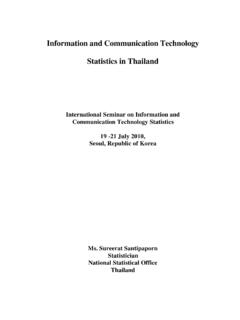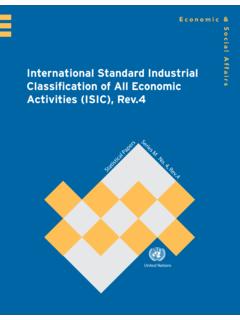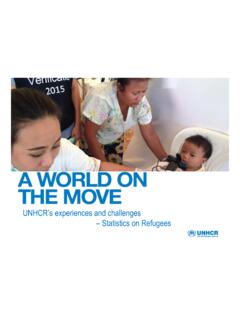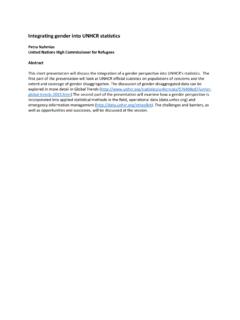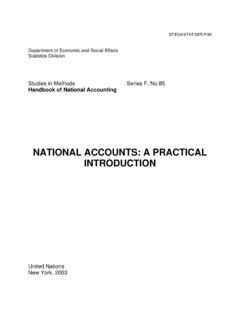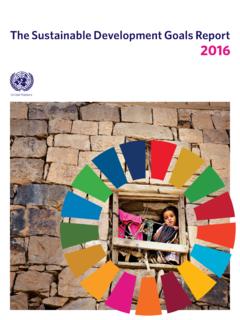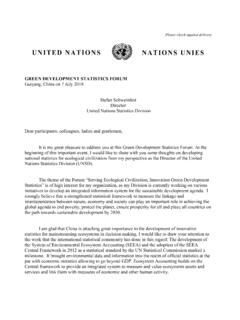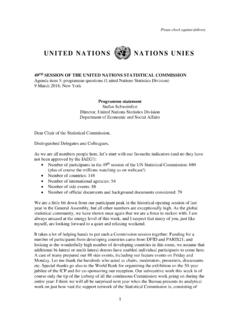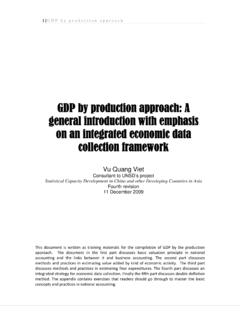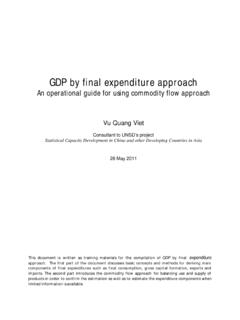Transcription of Guide on Measuring Human Capital - United Nations
1 UNECE The idea of viewing individuals knowledge and abilities as an asset as Human Capital can be traced back to the 18th century. But Human Capital is hard to define and measure. Policymakers are calling for ways to understand and quantify Human Capital , in order to better understand what drives economic growth and the functioning of labour markets, to assess the long-term sustainability of a country s development path, and to measure the output and productivity performance of the educational sector. Devising a robust methodology for the monetary valuation of the stock of Human Capital is especially crucial as studies suggest that Human Capital is the most important component of the total Capital stock in advanced Guide on Measuring Human Capital discusses conceptual, methodological and implementation issues and challenges.
2 The Guide shows how to estimate and record Human Capital in a way that is aligned with the principles of national accounts and that is comparable across Guide proposes the development of a satellite account for education and training, and provides an example demonstrating the impact of Human Capital on the values of the gross domestic product, investment, consumption, savings and net wealth. The Guide provides additional examples of how Human Capital has been measured in selected country-specific contexts and compared across countries. The Guide also shows how statistical agencies can address the challenges of constructing a Human Capital satellite ServiceUnited Nations Economic Commission for EuropePalais des NationsCH - 1211 Geneva 10, SwitzerlandTelephone: +41(0)22 917 44 44 Fax:+41(0)22 917 05 Nations United NATIONSG uide on Measuring Human CapitalGuide on Measuring Human CapitalGuide on Measuring Human CapitalUNECE United Nations ECONOMIC COMMISSION FOR EUROPE Guide on Measuring Human Capital Prepared by the Task Force on Measuring Human Capital United Nations New York and Geneva, 2016 Note The designations employed and the presentation of the material in this publication do not imply the expression of any opinion whatsoever on the part of the Secretariat of the United Nations concerning the legal status of any country, territory, city or area, or of its authorities, or concerning the delimitation of its frontiers or boundaries.
3 Acknowledgements This Guide was prepared by the UNECE Task Force on Measuring Human Capital , with the following composition: Ann-Lisbet Brathaug (Statistics Norway, chair of the Task Force), Hui Wei (Australian Bureau of Statistics), Wulong Gu and Ryan Macdonald (Statistics Canada), Alessandra Righi (Istat), Marieke Rensman (Statistics Netherlands), Simon Hall and Diane Ramsay (Statistics New Zealand), Gang Liu (Statistics Norway), Jacek Ma lankowski (Regional Statistical Office in Gda sk, Poland), Milena Jankovic (Statistical Office, Slovenia), Valerie Fender, Lee Mallett and Dominic Webber (Office for National Statistics, United Kingdom), David S. Johnson (Bureau of Economic Analysis, United States of America), Peter Van de Ven (OECD), Bilal Barakat (Wittgenstein Centre for Demography and Global Human Capital ), Michael Christian (University of Wisconsin-Madison), Barbara Fraumeni (Central University for Finance and Economics, Beijing), Tihomira Dimova, Andres Vikat, Fiona Willis-N ez and Christopher Jones (UNECE), and Art Ridgeway.
4 The Guide was developed and approved by the entire Task Force. Some members took primary responsibility for drafting certain chapters, as follows: chapter 1 by Ann-Lisbet Brathaug, chapter 2 by Peter Van de Ven, chapter 3 by Valerie Fender and Lee Mallett, chapter 4 by Marieke Rensman, chapter 5 by Alessandra Righi, Peter Van de Ven and Ann-Lisbet Brathaug, chapter 6 by Wulong Gu, and chapter 7 by Barbara Fraumeni. Art Ridgeway edited the entire Guide . Copyright United Nations , 2016 All rights reserved PRINTED AT United Nations , GENEVA, SWITZERLANDECE/CES/STAT/2016/6 iii Preface The idea of viewing individuals knowledge and abilities as an asset as Human Capital can be traced back to the 18th century. But Human Capital is intangible and hard to define, so in spite of its long history it has remained a challenge to measure.
5 Understanding and quantifying Human Capital is becoming increasingly necessary for policymakers to better understand what drives economic growth and the functioning of labour markets, to assess the long-term sustainability of a country s development path, and to measure the output and productivity performance of the educational sector. In view of this growing demand, in 2013 the Conference of European Statisticians (CES) established a Task Force on Measuring Human Capital . The objective of the Task Force was to pursue the conceptual development of Human Capital measurement, with a particular focus on developing experimental Human Capital satellite accounts. The Task Force was asked to develop guidelines and compile best practices to help countries construct experimental satellite accounts for Human Capital based on common methodologies.
6 This publication is the result of the work of the Task Force. It has been reviewed by countries through consultations carried out among CES members and relevant organizations in February-March 2016. Given the importance of Measuring Human Capital for the global statistical community, the United Nations Statistics Division carried out a global consultation among all United Nations Member States in July-August 2016. In October 2016, the CES Bureau endorsed the Guide . UNECE is grateful to the many experts who were involved in the development of this publication. iv Contents 1 Introduction ..1 Why this Guide ? ..1 Importance and policy relevance ..1 Overview of the Guide ..2 2 Concepts and definitions ..8 Introduction ..8 Defining Human Capital ..8 Human Capital and the 2008 SNA.
7 11 Recording and Measuring Human Capital as an asset ..13 Non-economic returns ..20 3 Methodological issues ..22 Introduction ..22 Methods and approaches to Measuring Human Capital ..23 The cost-based approach ..25 The lifetime income-based approach ..29 The indicators-based approach ..36 Volume indices ..38 Discussion of the different approaches ..40 Approaches in the Guide ..41 4 Implementation and measurement issues ..43 Introduction ..43 Measurement with the cost-based method ..43 Measurement with the lifetime income-based method ..54 Measurement with the indicators approach ..71 Concluding remarks ..72 Annex A. Implementation of the indirect approach ..74 5 Satellite account for education and training ..75 Introduction ..75 Key variables of the Satellite Account for Education and Training ..76 Identification of the products, producers and financial agents.
8 78 The main tables of the SAE ..84 The supplementary tables of the SAE ..90 Conclusion ..92 6 Human Capital satellite account: an example for Canada ..93 Introduction ..93 Measurement of Human Capital for a satellite account ..94 Human Capital as a produced asset ..95 Human Capital satellite account: cost-based approach ..97 Human Capital satellite account: income-based approach ..101 v Integration of the cost-based estimate of Human Capital in the CSNA ..102 Integration of the income-based estimate of Human Capital in the CSNA ..106 Conclusion ..107 Annex B. Tables ..109 7 Human Capital country studies ..123 Introduction ..123 Human Capital measures ..123 Comparison of alternative Human Capital measures ..125 Human Capital country measures not listed in the table ..127 Conclusion ..128 Examples ..129 8 Recommendations and further work.
9 133 Recommendations ..133 Further References ..137 vi List of tables Table International data sources for education and training 50 Table International data sources for costs of foregone work while on training .. 51 Table International data on average job tenure .. 52 Table International data sources on educational attainment .. 59 Table International data sources on enrolment .. 62 Table International data sources on school duration .. 63 Table International data sources for employment .. 64 Table International data sources for earnings .. 66 Table International data sources on mortality and life expectancy .. 67 Table International data sources on migration .. 70 Table International data sources on training .. 71 Table SAE Education Products and correspondence with CPC , ISIC , COFOG, COPNI, COICOP.
10 80 Table Transactions between financing agents and producers of education and training .. 84 Table Abbreviations used in tables and .. 109 Table Changes to sector accounts when Human Capital is produced in the household 110 Table Changes to sector accounts when Human Capital is produced in the sectors undertaking education and training and a Capital transfer mechanism is used.. 113 Table Costs of education and training, (billions of current dollars) .. 116 Table Costs of education and training as percent of GDP .. 116 Table Economic accounts of Canada in 2010, billions of current dollars .. 117 Table Household sector account in 2010, billions of current dollars .. 118 Table Corporate sector account in 2010, billions of current dollars .. 119 Table Government sector account in 2010, billions of current dollars.
